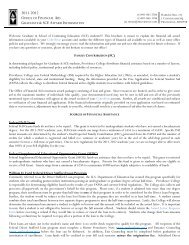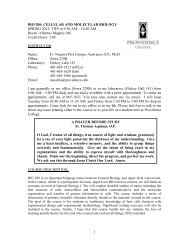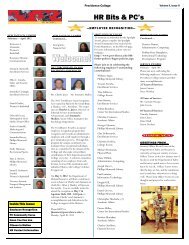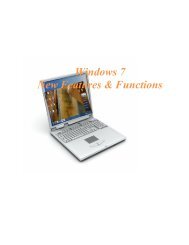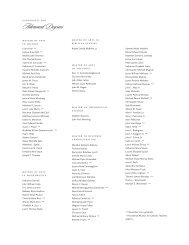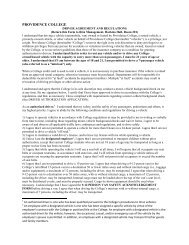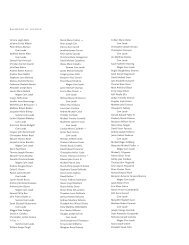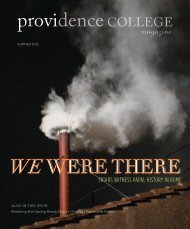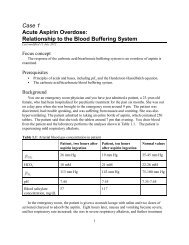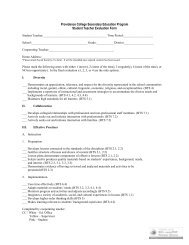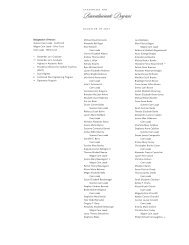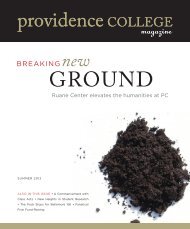Lesson Plan Sample - Providence College
Lesson Plan Sample - Providence College
Lesson Plan Sample - Providence College
Create successful ePaper yourself
Turn your PDF publications into a flip-book with our unique Google optimized e-Paper software.
<strong>Providence</strong> <strong>College</strong><br />
Teacher Certification Program<br />
<strong>Lesson</strong> <strong>Plan</strong><br />
Name: Karen Vendituoli Date: July 8, 2012<br />
<strong>Lesson</strong> Topic: Analyzing Editorials<br />
Course and Grade Level: 9 th grade CP English<br />
Duration: 80 minutes<br />
Essential Question: While reading editorials about contemporary issues, which strategies will students<br />
apply to determine the key elements of the text?<br />
Expected Outcome(s): Students will be able to implement the “PEAL” method when reading and<br />
analyzing an editorial. Students will be able to determine the purpose, state the evidence, decide if it<br />
makes the reader want to take action, and define what they have learned through reading various<br />
editorials.<br />
National Content Standards (NCTE):<br />
Common Core Standards:<br />
1
Materials:<br />
ELMO projector<br />
Warm-up notebooks<br />
Bell (Introducing “PEAL”)<br />
“PEAL” - Handout # 1<br />
“Should curfew be a law?” Editorial- Handout # 2<br />
Analyzing Editorials: Group Assignment – Handout # 3<br />
Editorials for Group Assignment- Handout # 4-7<br />
Anecdotal Notes - Handout # 8<br />
Presentation Notes- Handout # 9<br />
Learning Objectives:<br />
1. Students will identify the steps of analyzing an editorial through the use of the “PEAL” method.<br />
(DOK 1)<br />
2. Students will learn how to properly cite evidence for their editorial’s purpose through the use of the<br />
“PEAL” method. (DOK 3)<br />
3. Students will apply the “PEAL” concept as they work in groups to analyze each editorial. (DOK 4)<br />
4. Upon the completion of the group task, students will analyze their responses on the “PEAL” editorial<br />
worksheet. (DOK 3)<br />
5. Within each group, students will construct a presentation of their findings to their classmates. (DOK 3)<br />
Instructional Sequence:<br />
Time<br />
Needed:<br />
Activity<br />
Warm up/Review Activity<br />
The teacher will welcome the<br />
students into the classroom by<br />
ringing a bell and introducing the<br />
word “PEAL” to the class as the<br />
“word of the day”. The definition<br />
and an appropriate sentence will<br />
be used to help introduce the<br />
80<br />
Minutes<br />
Total<br />
5<br />
minutes<br />
Rationale<br />
The word of the day will help engage and hook students<br />
to find interest and learn the a new word and for what it<br />
will eventually mean for the lesson they will be<br />
completing.<br />
The warm-up activity will allow students to recall the<br />
information that was taught in the previous class (DOK<br />
1).<br />
2
word. The significance of this<br />
word will be revealed later.<br />
The teacher will now use the<br />
ELMO overhead to display the<br />
review questions for the lesson<br />
for the class.<br />
Students will be given the chance to review what they<br />
have learned previously and ask any questions or<br />
clarification with the subject that they may need.<br />
This activity will help to transition the class from<br />
learning the basics of an editorial to how to analyze one.<br />
As a class we will answer the<br />
first question together, (what is<br />
an editorial?).<br />
Next, the students will be told to<br />
answer the following two review<br />
questions in their warm-up<br />
notebooks and to be ready to<br />
share our responses.<br />
The class will share our<br />
responses and further our<br />
discussion if clarification is<br />
necessary.<br />
How to Analyze an Editorial<br />
After the warm-up the teacher<br />
will first ask the class to think of<br />
some strategies that they may use<br />
when analyzing an editorial.<br />
Students will be using their prior<br />
knowledge of their analytical<br />
skills to brainstorm different<br />
ideas on the whiteboard/ELMO.<br />
Next, the teacher will discuss the<br />
different purposes of editorial<br />
writing and how to provide<br />
evidence for the different<br />
purposes.<br />
Handouts of the “PEAL” steps<br />
will be distributed and reviewed<br />
before using it in context.<br />
Handout # 1<br />
The term “Peal” may be<br />
unfamiliar to students so the<br />
teacher will take this time to<br />
explain the term briefly with a<br />
proper definition and sentence<br />
(This may be used as the word of<br />
the day).<br />
10<br />
minutes<br />
Students will be asked to use their prior knowledge to<br />
brainstorm ideas on how they might analyze an editorial.<br />
They may use different concepts that have been taught<br />
concerning an analysis of a poem or short story that may<br />
be more familiar. This activity will help students to get<br />
thinking and become more familiar with the topic.<br />
The teacher will then introduce and teach the method that<br />
will be used when analyzing an editorial. The students<br />
should then be able to identify the steps to use when<br />
analyzing any editorial (DOK 1). This is an essential step<br />
as it lays the foundation for later scaffolding.<br />
3
Working with an Example<br />
The teacher will first write the<br />
title of the editorial on the<br />
whiteboard. Next, the teacher<br />
will ask the class to determine<br />
what the title of the article might<br />
suggest and briefly discuss our<br />
reasoning.<br />
The teacher will distribute copies<br />
of the editorial titled, “Should<br />
curfew be a law?”<br />
Handout # 2<br />
We will then read and discuss the<br />
article using the “PEAL” handout<br />
to better establish the<br />
significance of the editorial.<br />
As a class we will determine the<br />
purpose and state the evidence<br />
supporting the editorial’s<br />
purpose. Next, the teacher will<br />
tell the students to respond to the<br />
two remaining steps individually.<br />
(Agree? Disagree?)<br />
We will then share some of our<br />
responses and discuss our<br />
reasoning for each.<br />
Modeling the Task<br />
After reading the article the<br />
teacher will model the group<br />
assignment that will be<br />
completed using the “Should<br />
curfew be a law?” editorial.<br />
Handout # 3<br />
The teacher will be using the<br />
“PEAL” method to analyze the<br />
editorial with the class. The<br />
teacher will begin the assignment<br />
by reading the directions and<br />
choosing the first two editorial<br />
purposes and citing supportive<br />
evidence for each. The teacher<br />
will next call on different<br />
students to help complete the<br />
15<br />
minutes<br />
10<br />
minutes<br />
Once the methods are established, students will be<br />
predicting what the title of the first editorial may imply.<br />
This will allow students to use information that they are<br />
already familiar with and connect it to what we are now<br />
learning (DOK 2).<br />
As a class the editorial will be read aloud as each student<br />
will have a personal copy and must continue to follow<br />
along. As we read the editorial we will discuss key points<br />
to further our discussion and help gain knowledge to<br />
better analyze the piece.<br />
The teacher will be modeling the task given to assure that<br />
all students understand what is being asked of them.<br />
Students in all groups should have a strong understanding<br />
of the four different steps that are involved in analyzing<br />
an editorial.<br />
Identifying and predicting skills are the foundation to<br />
enable students to implement higher-ordered thinking<br />
strategies. The teacher will determine the purpose and<br />
show students how to properly cite evidence to defend its<br />
purpose (DOK 3).<br />
Students will be able to see how exactly the assignment<br />
should be completed which can then serve as an example<br />
when working on their own in groups.<br />
4
emainder of the assignment.<br />
Working in Groups<br />
The teacher will place students in<br />
groups of four and assign each<br />
participant a letter in the “PEAL”<br />
method to present out to the<br />
class. Each group will be<br />
analyzing a different editorial<br />
and must as group complete the<br />
assignment handout.<br />
Group #1- “How much is too<br />
much?<br />
Group # 2- “Relationships: The<br />
inside scoop”<br />
Group # 3- “Three beatings”<br />
Group # 4- “Are parents strict?”<br />
Handouts # 4-7<br />
The teacher will instruct students<br />
to read and discuss the editorial<br />
that is given to them as a group.<br />
Each group will be given the<br />
assignment and will complete it<br />
together.<br />
The teacher will monitor student<br />
progress by taking anecdotal<br />
notes on each group.<br />
Handout # 8<br />
Presenting your findings:<br />
Students will be asked to stand in<br />
the front of the classroom with<br />
their group and briefly present<br />
their findings using the “PEAL”<br />
method.<br />
For those students who are<br />
listening to each presentation,<br />
they will be given a handout to<br />
complete, ensuring that they<br />
remain engaged and interested.<br />
Handout # 9<br />
20<br />
minutes<br />
15-20<br />
minutes<br />
While working in groups of four students will be<br />
applying the “PEAL” concept that has just been taught<br />
and will implement it while analyzing each editorial<br />
(DOK 4).<br />
Students will carefully be analyzing their editorial piece<br />
within their groups by utilizing the “PEAL” method<br />
(DOK 3).<br />
This method will help students read closely and better<br />
understand the text since they will have to break down<br />
each part/segment of the piece.<br />
By the end of the group assignment all students should be<br />
able to closely and carefully read, understand, and<br />
analyze an editorial piece through the use of the “PEAL”<br />
method.<br />
Students will construct their assignment to be readily<br />
prepared to present their findings to their classmates.<br />
Continuing to build on previous instruction, students will<br />
be given the opportunity to listen to various different<br />
presentations to compare and contrast one another’s<br />
findings (DOK 3).<br />
5
Exit ticket (verbally):<br />
What was one thing you learned<br />
today?<br />
“We have now heard many<br />
different opinions on a variety of<br />
subjects. You may still have<br />
missed a point that one of your<br />
classmates found to be new and<br />
interesting to them.”<br />
“We will now go around the<br />
room and tell our classmates one<br />
thing we learned in class today.”<br />
2<br />
minutes<br />
The verbal exit ticket will help the teacher as well as the<br />
students to determine what they have learned from this<br />
lesson. Some students may mention the actual “PEAL”<br />
method or some may mention a point of view or<br />
knowledge of an editorial.<br />
Each student will be able to connect what he or she has<br />
learned to what they now know (DOK 4).<br />
Each individual will be able to learn something that<br />
he/she may have missed or not thought of. It will help all<br />
students to better connect the lesson together.<br />
Provision for Individual and Cultural Differences:<br />
1. Since writing is the most significant need for this student he will have a teacher aid in the<br />
classroom to help act as a scribe while completing the assignment.<br />
2. The teacher must have periodic check-ins throughout the whole lesson, making sure that the<br />
student understands each specific part to the assignment given and is completing it correctly.<br />
3. This student must still participate in any group work that is done. The presentation portion is<br />
also expected of this student. At this time the student will be partnered with general education<br />
students to assure success and clarity of the assignment given.<br />
4. Extra handouts will be given to the student with clear well written directions for each task<br />
given during the class.<br />
5. A Neo-Smart board will also be available if the student chooses to use it.<br />
6. The teacher will use the Elmo overhead projector for clarity in each handout and assignment<br />
given to all students.<br />
7. The student will have extended time to complete the written assignment.<br />
Assessment/Evaluation:<br />
The teacher will use formative assessment to measure the student’s progress within this lesson.<br />
The teacher will first assess the students by using the warm-up activity. This activity will help the teacher<br />
to determine what students understand regarding the introduction of this unit/subject. The teacher will<br />
then determine whether or not clarification is needed. If it is essential to review further the teacher will<br />
provide various examples with clear details before moving forward with the lesson.<br />
6
Next, the teacher will assess the students by their participation within the group discussion as we analyze<br />
the editorial as a class. This will allow for all students to participate and state their opinions and reasoning<br />
for how they feel and what they think about the article that we have just read.<br />
The teacher will monitor student’s progress during the group work task. The teacher will monitor progress<br />
by taking anecdotal notes on each group as they complete the assignment.<br />
A completion/participation grade will also be assessed through the group work assignment and<br />
presentation. All group members will be graded on their contribution and participation in the assignment.<br />
As mentioned earlier all students must participate in this presentation and take a certain letter from the<br />
“PEAL” method to assure that it is equal. Each student will report to the class their findings as a group for<br />
each letter in the method.<br />
The teacher will use summative assessment to assure that all students are remaining engaged and<br />
interested during each presentation, as students will be asked to complete a handout for each presentation.<br />
This will help to measure what each student is learning and retaining from watching each presentation, as<br />
they display what they have learned.<br />
The teacher will also formatively measure the student’s knowledge of the subject as the teacher hears the<br />
different responses from each student as they briefly share with the class what they have learned from<br />
today’s lesson.<br />
Reflection:<br />
7
Name: _____________________________________<br />
Ms. Vendituoli<br />
Date: _________________________________<br />
English 9 CP<br />
Analyzing Editorials- “PEAL” Method- Handout # 1<br />
P<br />
E<br />
A<br />
L<br />
-Determine the Purpose<br />
-State the Evidence<br />
-Did this make you want to take action?<br />
-What did you Learn?<br />
“Should curfew be a law?” –BY: Samantha Cappas<br />
P___________________________________________________________________________________<br />
_____________________________________________________________________________________<br />
_____________________________________________________________________________________<br />
E____________________________________________________________________________________<br />
_____________________________________________________________________________________<br />
_____________________________________________________________________________________<br />
A___________________________________________________________________________________<br />
_____________________________________________________________________________________<br />
L____________________________________________________________________________________<br />
_____________________________________________________________________________________<br />
_____________________________________________________________________________________<br />
Peal: noun<br />
8
Should Curfew be a Law?<br />
Posted on May 17, 2012<br />
HANDOUT # 2<br />
BY SAMANTHA CAPPAS – Staff Writer<br />
Many teenagers do not feel the need to have curfew. Teenagers go home early for 180 days out of the<br />
year for school. Why punish adolescents with having to go home early over the summer? Summer is<br />
supposed to be all about fun and relaxation. Why have a curfew if a lot of these teenagers do not comply<br />
with it? It is just a waste of time trying to keep teens off the street.<br />
In my opinion, I feel that half of the student population gets fined because of the harsh curfew. Teens<br />
believe that curfew should not be a must. There’s no point if teens do not comply and still try to go out.<br />
Many parents do not follow the curfew during the summer. Parents just let their teens do whatever they<br />
want.<br />
As much as students want to have fun, parents do too. I feel parents usually let teens stay out and party<br />
with friends or even with them. Junior, Luis Martinez, was asked how he felt about the curfew and he<br />
stated, “I feel there is no need for it because teens stay out after curfew anyway. The more you keep a<br />
child locked in, the more they are going to want to party.” I agree with Martinez because I hate when my<br />
mom keeps me locked in the house babysitting, or just having to stay home.<br />
There should be an end to curfew. Time is being wasted trying to keep teens stuck inside when it probably<br />
would just make them want to go out even more.<br />
9
Name: _________________________________<br />
Ms. Vendituoli<br />
Date: _________________________________<br />
English 9 CP<br />
Analyzing Editorial Purposes-Part I<br />
Analyzing Editorials: Group Assignment/Presentation<br />
HANDOUT # 3<br />
Directions: Determine the most fitting purpose for your editorial and find evidence from the article to<br />
support each choice. You may think of your own purpose if you feel it is necessary. Choose AT LEAST<br />
five.<br />
1. Start movements 6. Uplift the community<br />
2. Applaud courage 7. Praise ideas<br />
3. Expose dishonesty 8. Criticize ideas<br />
4. Propose change 9. ___________________<br />
5. Inspire action 10. ___________________<br />
Editorial Purpose #<br />
_________<br />
Evidence Statement from Editorial<br />
________________________________________________________<br />
_________<br />
________________________________________________________<br />
_________<br />
________________________________________________________<br />
_________<br />
________________________________________________________<br />
_________<br />
________________________________________________________<br />
_________<br />
________________________________________________________<br />
Part II<br />
10
Title of Editorial: __________________________________________________________________________<br />
Author: ______________________________________________________________________________________<br />
Directions: Choose ONE purpose from the list and provide your evidence for its purpose. State your<br />
groups’ feelings concerning the editorial by completing the “A” and “L” portion of the “PEAL”<br />
method.<br />
P______________________________________________________________________________________________<br />
_______________________________________________________________________________________________<br />
E______________________________________________________________________________________________<br />
_________________________________________________________________________________________________<br />
_________________________________________________________________________________________________<br />
_________________________________________________________________________________________________<br />
A______________________________________________________________________________________________<br />
_________________________________________________________________________________________________<br />
_________________________________________________________________________________________________<br />
L______________________________________________________________________________________________<br />
_________________________________________________________________________________________________<br />
11
How Much is Too Much?- GROUP 1<br />
Posted on May 8, 2012<br />
HANDOUT # 4<br />
BY KATTYA PALACIOS -Staff Writer<br />
As youngsters in middle school, relationships and affection were something very scandalous. Public<br />
Displays of Affection (PDA) were not tolerated. Every teacher harshly enforced PDA and even hugging<br />
friends was not allowed. If the rule were broken then there would be consequences, for example after<br />
school detention. High school deals with PDA in a completely different way. It seems as if consequences<br />
for PDA no longer exist.<br />
It’s understandable that now is the time when students are maturing and gaining more freedom. But, there<br />
must be some kind of line drawn. “Kissing no, but hugging and holding hands I can accept,” stated Mr.<br />
Bensing. “Holding hands, and hugging is not a disruption, but sucking faces is,” senior, Mikea<br />
Lansenderfer replied in agreement with Mr. Bensing. Greeting friends in between classes with a hug or<br />
sometimes a kiss on the cheek is common. The problem usually occurs with couples.<br />
Holding hands is an innocent thing to do. The line is crossed when couples are exchanging saliva in the<br />
middle of the hallway while other students are trying to get to their classes. I appreciate teachers giving us<br />
the freedom to make independent choices, but sometimes students abuse that freedom.<br />
Excessive PDA is an act that some students may not want to view during their school day. Students<br />
should be reminded periodically about how much affection should be shown so that they do not get out of<br />
control.<br />
Relationships: The Inside Scoop- GROUP 2<br />
Posted on May 3, 2012<br />
12
HANDOUT # 5<br />
BY ALEX PYLES - School News Editor<br />
Three Beatings- GROUP 3<br />
13
Posted on May 1, 2012<br />
HANDOUT # 6<br />
BY SARAH HOCKER - Staff Writer<br />
Violence is behavior involving physical, mental, or sexual force intending to hurt someone or something<br />
(www.learnersdictionary.com). Physical abuse is being hit, kicked, shoved, etc. Mental abuse is someone<br />
talking down to someone else, telling them that they do nothing right, or constantly yelling at them.<br />
Sexual abuse is rape or being touched inappropriately without someone’s permission. There is violence<br />
towards people all the time and it needs to be stopped immediately.<br />
Most instances of violence occur in abusive relationships. These include parents to children, boyfriends to<br />
girlfriends, or husbands to wives. The best thing to do if someone is in an abusive relationship is to get<br />
out of it right away. If this is not possible, talk to someone right away. There are hotlines people can call<br />
if they are being abused and do not know what to do. There are people that anyone can talk to that would<br />
give him or her advice on what to do when in an abusive relationship. For example people can talk to a<br />
counselor or their mother or father.<br />
If anyone knows someone who is being abused, tell a counselor or someone trustworthy right away so the<br />
person getting hurt can receive help and be freed from violence; do not procrastinate! Remember, there is<br />
always an alternative to being in an abusive relationship. All a person has to do is reach out to someone<br />
for help.<br />
Are Parents Strict?- GROUP 4<br />
Posted on April 10, 2012<br />
HANDOUT # 7<br />
14
BY SAMANTHA CAPPAS – Staff Writer<br />
Teenagers are losing their parent’s trust. They go out, get drunk and party when they are not supposed to.<br />
Some teenagers don’t listen and do whatever they want whenever they want.<br />
This causes many female teens to go out and get pregnant. Most male teens are in jail or close to it. Why<br />
is that? There are teens who do not listen to his or her parents when spoken to. Are parents giving teens<br />
too much freedom? Sadly, yes, most students are gone all day and night.<br />
In order to solve this problem should parents look into boot camps for those who don’t listen and are a big<br />
problem? If parents care and are worried, it’s probably the best option. Teens need love and a role model<br />
to look up to. These years of someone’s life are the most important. Peer pressure and negative<br />
interference can influence a teenager’s life in a huge way.<br />
Honestly, I think that parents need to do what is best for their child and stick to their guns if they really<br />
care about their future. No mother or father wants to see his or her child grow up to be failure. I feel that<br />
parents need to take more responsibility for their children. There is no need to let your child be alone,<br />
especially if she is a girl. Girls do not belong in the streets. Parents need to realize that their child is<br />
wasting their time partying when they could be doing something that will benefit their future.<br />
15
Anecdotal Notes for Group Work- Handout # 8<br />
Group #<br />
Names<br />
Editorial Title<br />
P E A L<br />
1-<br />
“HOW MUCH IS TOO<br />
MUCH?”<br />
Jackie (P)<br />
Lee (E)<br />
Bryant (A)<br />
Cassandra (L)<br />
2-<br />
“RELATIONSHIPS:<br />
THE INSIDE SCOOP”<br />
Bobby (P)<br />
Tyler (E)<br />
Jen (A)<br />
Lucy (L)<br />
3-<br />
“THREE BEATINGS”<br />
Ashley (P)<br />
Shannon (E)<br />
Anthony (A)<br />
Andrea (L)<br />
4-<br />
“ARE PARENTS<br />
STIRCT?”<br />
Grace (P)<br />
James (E)<br />
Ava (A)<br />
Lucas (L)<br />
16
Group # 1<br />
Title: __________________________________________________________________________________________<br />
What did I learn?<br />
_________________________________________________________________________________________________<br />
_________________________________________________________________________________________________<br />
Group # 2<br />
Title: __________________________________________________________________________________________<br />
What did I learn?<br />
_________________________________________________________________________________________________<br />
_________________________________________________________________________________________________<br />
Group # 3<br />
Title: __________________________________________________________________________________________<br />
What did I learn?<br />
_________________________________________________________________________________________________<br />
_________________________________________________________________________________________________<br />
Group # 4<br />
Title: __________________________________________________________________________________________<br />
What did I learn?<br />
_________________________________________________________________________________________________<br />
_________________________________________________________________________________________________<br />
17




